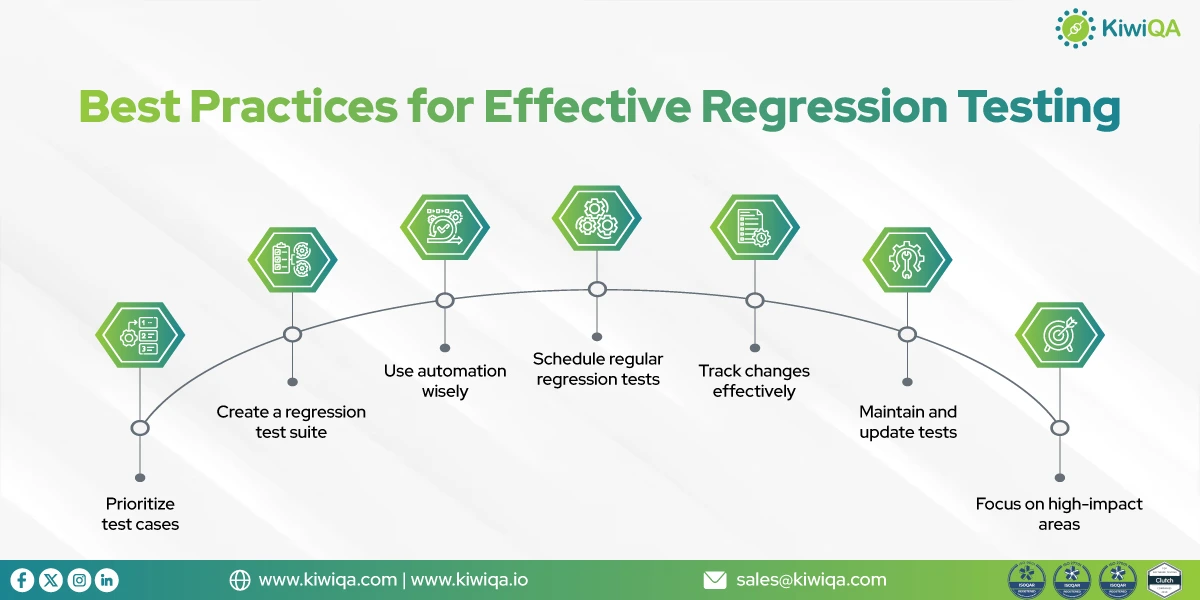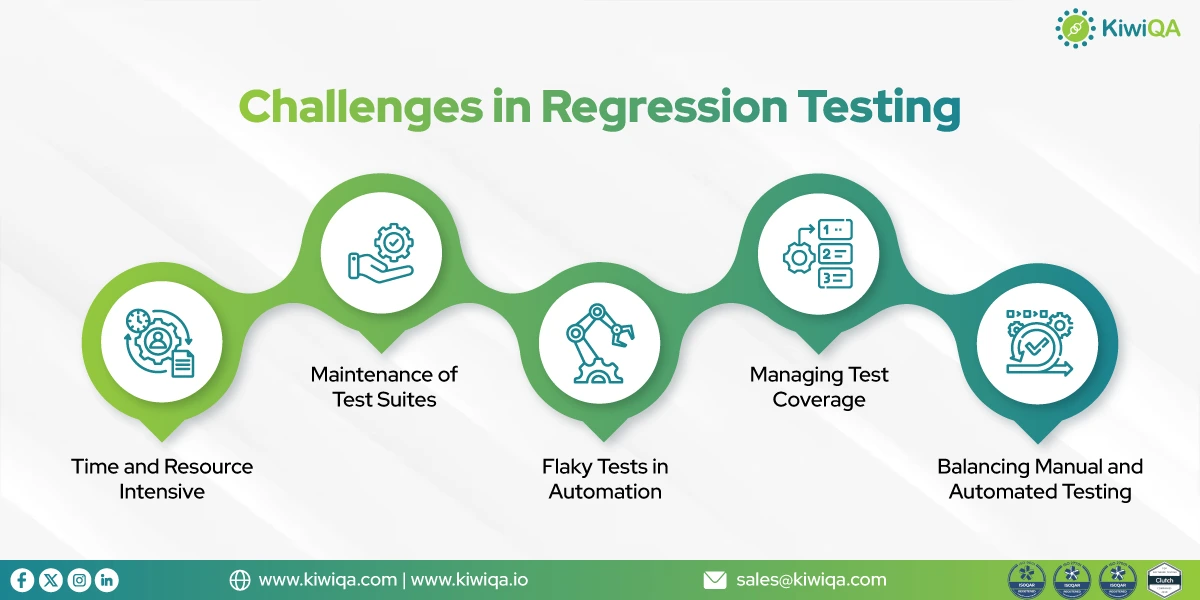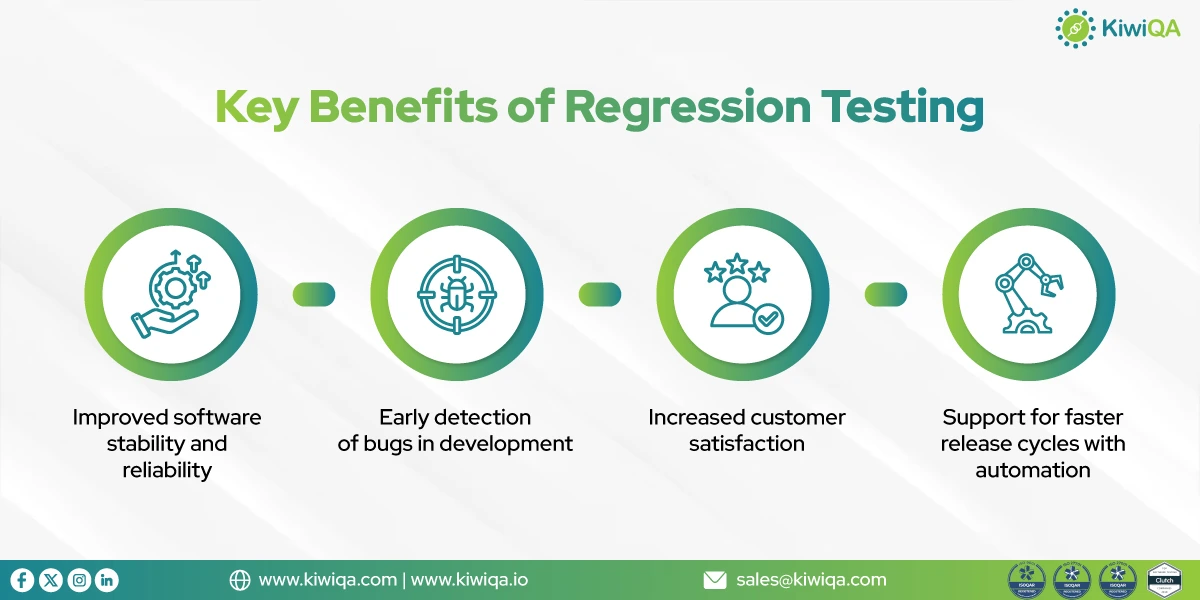In this fast-driven world, the development of software is an ever-evolving dynamic process. However, adding new functionalities and bug involvement may disrupt the functionality of your application. Automated tests, such as unit tests, are necessary for validating that individual coding component, but they frequently fail to safeguard the app’s behavior. In this scenario, regression testing helps you. Based on a research report, 78% of organizations now prefer to automate their regression testing. So, what is regression testing?
Want to know what is regression testing in QA? Regression testing is a process utilized for assuring the quality of software even after including new functionalities. To measure & fix the unintended complications that damage the user experience & stability, the business should retest their application timely. As per the study, regression testing assists in saving 60% of time & 40% of cost.
Regression testing works like a shield that verifies the application is functioning even after the development & app customization. Basically, regression testing is performed quickly after the developer introduces new features or resolves the bugs. It is recognized as an important aspect of the SDLC process and holds a strong position among multiple testing methodologies. The following blog contains a brief about what is regression testing in software testing & its best practices.
What is Regression Testing?
Let’s check what is regression testing. Regression testing is similar to the black box testing technique utilized for authenticating and customizing the software codes and doesn’t impact the existing software functionalities. Regression testing proves the application is working seamlessly even after changes in functionalities, bugs are fixed, etc.
Furthermore, it ensures the developed software is still functioning efficiently & effectively. It ensures that the newly added source code functions won’t affect the existing functionalities and application stability. Regression testing services are utilized at the time of changes in code & for the improvement after configuration. It is used to assess the current behavior of software and compare it with the previous version. So, we can say regression testing is a method of verifying reliability & quality. Now check, what is the purpose of regression testing.
Why is Regression Testing Important?
➯ Safeguards Your App from New Bugs
Manu people want to know, what is regression testing in software testing? Regression testing involves writing tests for a known bug & re-running the test after every necessary change to the code base. Regression testing aims to assess any changes to the code base. Furthermore, it also aims to safeguard the app from new bugs.
In Agile software development, there is an approach to adopting the iterative process. The testing ensures that with frequent changes, the software won’t change its stability & efficiency. It is performed to measure whether the customization has caused new errors in the existing functions.
➯ Enhances Software Quality and User Experience
Another reason why businesses should approach regression testing is that it enhances the overall quality of software. Finding the defects in the functionality of recent code changes ensures the development team fixes them before production. Bugs can cause significant consequences on software quality.
Have you ever imagined what your customers would experience if they visited your e-commerce site and suddenly it crashed? Furthermore, it creates a negative impression, and they won’t come back to your site again. If the error isn’t found & fixed in time, it could lead to lost revenue & bad customer experiences.
What is the purpose of regression testing? Finding & fixing bugs is the aim of regression testing and assisting quality software by eliminating all the defects. By uncovering the bugs earlier, you can ensure your development team fixes them before they cause any issues. By taking a positive approach to this process, businesses can get peace of mind and offer safeguard applications against potential issues. Furthermore, regression testing is necessary to accelerate the user satisfaction rate.
Also Read : What is AEM Testing? A Complete Guide For Beginners
When you hire a regression testing expert, they will better help you to understand what is regression testing in QA. They will ensure that the software works as expected. It allows business owners to avoid negative feedback & complaints.
Now, let’s understand what is regression testing with examples. For example, you are working on a new feature for your e-commerce website, and after implementing the feature, you find that there is an issue occurring during the checkout process. Would you like to revisit the website once again? It would be a major problem for businesses and impact user’s trust. By following the right practices of regression testing, businesses can avoid such issues and give their users a satisfying & seamless experience.
➯ Supports Continuous Integration and Delivery (CI/CD)
A regression testing approach is necessary for the CI/CD & Agile process because it verifies that the changes in new code don’t break the existing functionalities and maintains the software quality & stability. Let’s take a brief understanding of What is regression testing in software testing. In the Agile methodologies, frequent delivery and continuous iterations of new functionalities need constant verification to ensure the previous features remain unaffected.
The CI/CD pipelines automate the process, enable efficient & faster testing with the integration of codes, and catch defects easily & smartly. Furthermore, it eliminates the risk of errors, ensures streamlined user satisfaction, etc. The regression testing supports the Agile principle for delivering faster updates when maintaining the highest standard of app reliability & quality.
➯ Essential for Maintaining Applications
Furthermore, regression testing assists in improving the application’s stability. When a business follows this approach, it can successfully uncover new errors in software and make its application more stable & error-free. There is less chance of malfunction & application crashes when you perform regression testing by qualified experts. Moreover, it also helps businesses detect whether their software can handle any further customization without affecting stability.
When to Perform Regression Testing?
Regression testing must be conducted in a timely manner to avoid any new bugs after the integration of functions in the application. Furthermore, regression testing improves the compatibility errors that could arise when you add new functionalities. It proves there are no adverse effects to the existing system, even after changes. You must take a streamlined approach because of the following reasons for automation regression testing –
➯ Introduction of New Features
Introducing new features, like adding a social media login facility to the existing email-based login application, can have adverse impacts on existing features. Regression testing ensures the features frequently operate in the right way without harnessing the existing quality.
➯ Elimination of Any Functionalities From the Existing System
Removal of features from the existing application, like “password remember,” also needs regression testing to verify that the other section of the application is working seamlessly.
➯ Fixing Bugs
Rectifying defects, like fixing broken login buttons, requires regression testing to avoid unintended consequences.
➯ Improvement in Performance
Performing application optimization can also have some negative impacts on the application. Reducing the loading time of the home page introduces new errors, and that’s when businesses can use regression testing to address & fix the errors.
➯ Longer Development Cycles
For larger-scale projects, regression testing is necessary to maintain the quality of software over an extended period. Frequent testing can easily catch the errors earlier in the system.
➯ Changes in Environment
Modifying the app environment, like switching the database from MySQL to Oracle, requires regression testing for confirmation of compatibility & the app integrity. Regression testing can protect the existing functionalities & assist in maintaining system compatibility and stability.
Best Practices for Effective Regression Testing
Regression testing helps to measure the developed and tested software application functions effectively after code changes. Below are the few listed advanced best practices for regression testing that assist in effective functioning.
➯ Prioritize Test Cases
Prioritizing test cases is crucial in regression testing based on the importance of the application. Furthermore, it ensures the major components are verified. You can’t test all the critical tests at once since they give you a vast number of test results that you are probably not capable of handling. Instead of this, you can prioritize the test case depending on the:
- How likely is the customization to impact your tests
- Whether there’s a history of bugs
- How crucial are the processes & features you are testing
- How users are utilizing the software
The successful regression testing is based on selecting the right test case. The cases you choose should cover a wide range of functionalities & failures and focus on the areas that are necessary for user experience & business operations. When choosing the test cases, keep in mind the comprehensive factors-
- Consider sections that have a better probability of bugs
- Prioritize the test case with a high level of impact to a low level.
- Test all the features & flows which are consecutively used by the customers.
- It includes testing complex features & those with various dependencies.
Prioritization of test cases includes measuring the potential impact of failures on user experience & organization operations. Incorporating the risk assessment includes the chances of failure.
➯ Create a Regression Test Suite
An unorganized test suite can lead to inefficient testing & missed defects. For every business, it is necessary to continuously update, review, and organize the test case. Eliminating outdated tests & incorporating advanced test suites lead to software quality improvement.
The well-structured test suite enables quick test execution & verifies the appropriate tests are conducted at the right time. Design regression test suite is based on the desired purpose & balances the scope.
Evaluating what to include in the regression testing suite starts with the scope assessments. The testing & development team uses regression testing for multiple purposes. The test case selection requires analysis to develop an effective regression test suite.
The major consideration for developing an effective regression test suite is a selection of test cases. Choose a test case based on the demand & scope of regression test suites. Remember to include the test cases in components where the error probability is high.
➯ Use Automation Wisely
Manual testing is repetitive & consumes more time, and that’s why the utilization of automated regression testing saves time and minimizes the chances of human errors. Automation tools like Katalon & Selenium allow the running of larger test batches with minimal intervention.
Using automation wisely ensures that frequent changes in the codebase are automatically verified. The automated regression testing minimizes the time & effort required for testing.
By incorporating the automated tools, the organization can enhance test coverage & improve test accuracy. Automation tools minimize the chances of repetitive tests & avoid human errors.
➯ Schedule Regular Regression Tests
You must verify the testing suite is updated frequently at the scheduled time. It is necessary to reflect any changes in the software application. Furthermore, it helps to avoid the issues from being missed during testing.
➯ Track Changes Effectively
Furthermore, regression testing is necessary to track & report the bug before time. It will notify the testing team if any changes are found. Moreover, it ensures that all the bugs are revealed & the quality of the app is enhanced.
➯ Maintain and Update Tests
Maintenance is necessary during regression testing. Always utilize reliable & stable identifiers initially. Select the automation tools wisely by ensuring that they will handle the expected changes. Stable environments are necessary to eliminate the failures related to the application. Moreover, test updating is also necessary; however, instead of updating tests in every change, ensuring testing tools are utilized enables the design of the centrally updatable modules.
➯ Focus on High-impact Areas
Prioritize the test case by predicting the high-risk areas of application. For balancing the quality & stability of your application, regression testing sets a strong presence. To achieve a top-notch application, it is good to prioritize the test case smartly. Start ranking based on the critical, high-impact test scenario, which covers the core features of the app. When you expand the testing scope, follow the risk based on the necessary parts of the software.
Also Read : Finding the Right Performance Testing Partner: Key Points to Consider
What Are the Challenges in Regression Testing?
1. Time and Resource Intensive
Regression testing takes time to complete. The testing involves running existing tests again, which may be complicated. To perform regression testing successfully requires lots of time and resources, especially when you are testing bulk & complicated software. Performing the regression testing manually requires the involvement of additional staff to fulfill the tests.
Furthermore, it could cause increased costs and also delays throughout the development process. Therefore, it is necessary to organize and set an effective plan for regression testing effectively. Moreover, it necessitates the requirement of comprehensive resources in the testing.
2. Maintenance of Test Suites
To balance the complexity & time of regression testing, one first ensures that proper maintenance is done. Regression testing is complex and takes more time. The quantity of test cases, functions & processes they check is in thousands, which definitely leads to becoming a big mess. The test engineers can’t complete the process manually. This is why automating the testing procedure is necessary.
3. Flaky Tests in Automation
Regression tests work best when they evaluate issues before production. However, there is nothing more frustrating than the test suite, which throws constant flakiness. The flaky tests generate false positives that are frustrating for the stakeholders, testing team, and developers.
4. Managing Test Coverage
Incomplete testing is another task to complete. If the regression testing team doesn’t give coverage to the additional features & functionalities of the software app, it may lead to undetected bugs & errors. Further, it could lead to poor-quality software and a bad user experience.
5. Balancing Manual and Automated Testing
Getting the right balance between automated & manual testing includes consideration of multiple factors. Moreover, it involves team skills, budget needs, project needs, and application types. Below are some tips to consider for balancing the automated & manual testing.
ㅇ Identify the suitable test scenario
Evaluate which test scenarios are likely suited for manual testing & which can be automated.
ㅇ Give more concern to critical areas
Businesses should focus on automated testing efforts on critical functionalities, repetitive test cases & high-risk areas to improve the test coverage & risks.
ㅇ Improve the collaboration
Businesses should collaborate with the automation experts and the manual testers, developers & other stakeholders to leverage expertise & strengths.
ㅇ Invest in automation
Businesses should invest in automation rather than manual regression processes. Regularly reviewing & updating the automated test suites verifies effectiveness & relevance.
ㅇ Frequent evaluation
Measure the effectiveness of testing approaches & adjust the balance between automated & manual testing depending on the project dynamics, feedback & customized requirements.
What are the Key Benefits of Regression Testing
Let’s find out what is the purpose of regression testing? The traits of regression testing extend across multiple aspects of software development. By frequently implementing regression tests, businesses can significantly reduce risks and quality of software & enhance overall efficiency.
1. Improved Software Stability and Reliability
The leading benefit of using regression testing is verifying the reliability & security of the app. Whenever the developers initiate a change, there is a risk that there may be an error in the application. Regression testing helps to mitigate the risks by ensuring the existing feature is functioning well.
When you hire experienced software developers, they perform the tests manually or use specialized advanced tools to perform automatically. Moreover, the manual testing is prone to human errors & time-consuming. By using the comprehensive automation regression testing process, you can accelerate the process & improve accuracy. The following methods lead to a stable & reliable product.
2. Early Detection of Bugs in Development
Customization of the software code may introduce defects & bugs and lead to performance issues & system failure. Performing comprehensive regression testing assists in measuring the earlier bugs in the development process, enabling them to save time and effort. Failure to perform tests before launching software may result in low-quality software that further leads to crashes and security errors. Performing regression testing before releasing software can significantly improve reliability & quality.
3. Increased Customer Satisfaction
By using regression testing approaches, businesses can expect top-notch apps to have limited errors. Furthermore, it directly contributes to improved customer satisfaction & loyalty. Regression testing verifies the software is stable, error-free, and matches the customer’s needs.
Integrating the right regression testing approaches improves the quality of products, minimizes the risks, detects the bugs earlier, saves costs, and delivers faster time to the market. When businesses use regression testing, it helps to ensure the quality & stability of the app. Regression testing ensures the quality of the application is the same even after the changes.
4. Support for Faster Release Cycles with Automation
Automated regression testing ensures that the testing doesn’t hold up software release cycles. Automated regression testing assists in enhancing the app’s performance & stability. As the app becomes more complicated with every upgrade, manual regression methodologies increase the chances of human mistakes. Automation assists in limiting the possibility of errors made by humans.
Worried About Bugs After Updates? Talk to Our Testing Specialists!
When regression testing is done incorrectly, it can lead to defective software. Developers frequently neglect to prepare or carry out comprehensive regression testing procedures when they lack a reliable regression testing expert. Hope you have understood the whole guide. Let’s take a quick recap on what is regression testing?
What is regression in software testing? An essential component of agile programs is regression testing.
Additionally, it is essential for companies and brands who wish to be digitally secure. Thus, it is impossible to doubt the need for skilled software testing services, particularly those that offer regression testing and test automation. Selecting a reliable expert will provide improved performance and reliable features every time.
Regression testing verifies that a software program’s present features have not been negatively impacted by recent changes. The following approach utilizes automated tools to access a lot of tests often, ensuring performance and reliability after updates & offering a comprehensive analysis of any issues.
Even though regression testing requires a lot of resources, it saves you both effort and time. Throughout the agile software development lifecycle, it maximizes production while simplifying the lives of programmers and testers. If you have any requirement for bug rectification after updating the application, then talk with the regression testing company.










